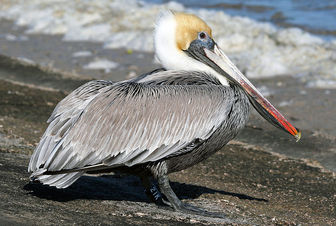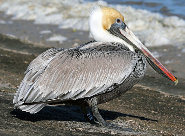Brown Pelican
It occurs on coasts in the Americas from Washington and Virginia south to northern Chile and the mouth of the Amazon River, as well as the island of Saut d'Eau in Trinidad and Tobago. Some immature birds may stray to inland freshwater lakes. After nesting, North American birds move in flocks further north along the coasts, returning to warmer waters for winter. Their young are hatched in broods of about 3, and eat around 150 lbs. of fish in the 8-10 month period they are cared for.

Original source: Transferred from en.wikipedia; transferred to Commons by User:Sreejithk2000 using CommonsHelper.(Original text : I (Terry Foote (talk)) created this work entirely by myself.)
Author: Terry Foote. Original uploader was Terry Foote at en.wikipediaPermission(Reusing this file)CC-BY-SA-3.0.
Brown Pelican - Survives Extinction
 The Brown Pelican (Pelecanus occidentalis) is the smallest of the eight known species of pelicans. Despite this, the bird is much larger than most coastal creatures, ranging from between 42-25 in (106-137cm) in body length and 6-12 lb (2.75-5.5kg) in weight. As the name implies, a young pelecanus occidentalis is entirely brown, but changes to a gray, white, and brown shade as it matures.
The Brown Pelican (Pelecanus occidentalis) is the smallest of the eight known species of pelicans. Despite this, the bird is much larger than most coastal creatures, ranging from between 42-25 in (106-137cm) in body length and 6-12 lb (2.75-5.5kg) in weight. As the name implies, a young pelecanus occidentalis is entirely brown, but changes to a gray, white, and brown shade as it matures.
The pelican resides in nearly all coastal areas, including the Gulf Coast, Nova Scotia, Chile, Venezulea, and British Columbia. Because the brown pelican can be spotted along the coast, both Barbados and the Turks and Caicos Islands have named the creature their national bird. In addition, the brown pelican is also the state bird of Louisiana.
The animal is most known for it's unique method of hunting prey. Similar to seagulls and unlike any other species of pelican, the pelecanus occidentalis will dive into the water for it's food. The creature starts by flying up into the air above water. When fish or crustaceans are spotted, the wings of the bird go limp as it dives straight down into the water. Once in the water, the pelican uses it's large scoop-like mouth as a net to capture dozens of fish or other creatures. Typically the bird consumes herring, mullet, silversides, and other fish species, however the pelican has been known to eat shrimp, prawns, krill and crabs as well.
Because the brown pelican lives along the coast, there aren't always trees for the creature to nest in. Because of this, nests are often made in sand or bushes. The female will build the nest out of materials that the male brings, then lay an average of three eggs per mating season. Both the male and the female will take turns incubating the eggs with their feet until hatching times. Once hatched, the pelicans must be very weary of predators, as cats, gulls, and skunks have been known to eat young pelicans since they are at ground level and unable to fly.
As an adult, the brown pelican's only predator is man-made pollution. Like most coastal animals, pelicans are extremely sensitive to chemicals that end up in the water. Two chemicals in particular, DDT and dieldrin, nearly killed off the species in the early 70s. Due to constant exposure to the chemicals, the shell of the pelicans eggs became increasingly fragile until it was unable to properly shelter embryos. The birth rate of the brown pelican dropped significantly, and the animal was placed on the endangered species list. Once this was discovered, the use of the chemicals were banned and the bird was able to be successfully saved and is now thriving.
Picture of the brown pelican by Terry Foote, licensed under the Creative Commons Attribution-Share Alike 3.0 Unported license.
The Brown Pelican is classified as Least Concern. Does not qualify for a more at risk category. Widespread and abundant taxa are included in this category.

Original source: Jason Weckstein
Author: Jason Weckstein
Permission: Some rights reserved
Family : Pelecanidae
Genus : Pelecanus
Species : occidentalis
Authority : Linnaeus, 1766

